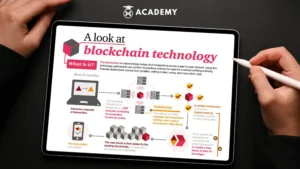Blockchain is a technology with the concept of a “chain of blocks,” which contains data related to one another.
Blockchain allows distributed systems to record transactions and store data.
In Blockchain, there is the term node, a device connected to the Blockchain network and has the function of maintaining, consolidating, verifying, and adding new transactions to the network.
Nodes are divided into two types:
1. Full Node, which functions to store all transaction history.
2. Light Node, which functions to store the required transaction data.
These two nodes are essential in maintaining data integrity and running processes in the Blockchain network.
History of Blockchain

Blockchain development began in 1991. At that time, computer scientists proposed an idea about the use of cryptography.
It was hoped that this cryptographic technology could be used to create a distributed and immutable ledger, but the technology at that time still needed to support and enable it.
After that, in 2008, an anonymous individual or group using the name Satoshi Nakamoto released a whitepaper explaining Blockchain technology and Bitcoin digital assets.
In 2009, Bitcoin was officially released and became the first digital asset to use Blockchain technology.
Only a few people knew about and used Bitcoin in the following years.
However, in 2013 Bitcoin and its popularity began to increase, leading to increased interest in Blockchain technology.
Since then, Blockchain technology has begun to be applied in various fields. In 2017, Initial Coin Offering (ICO) emerged and became a popular way to raise funds for new Blockchain projects.
Blockchain technology is still developing, and there is still much potential for this technology that has yet to be implemented and known.
Blockchain technology is expected to develop and be used in various other fields.
How do Blockchains Work?

Then, how does Blockchain work? The following is a description of the stages of how Blockchain works:
1. Transactions
Users make transaction requests in the Blockchain network.
2. Nodes
Then, the requested transaction request is broadcast to the P2P network of computers, known as nodes.
Nodes in the Blockchain network will validate transactions concerning the Blockchain protocol used.
3. Validation
After the network receives a transaction, it must be validated by the network.
Validation is carried out to ensure that transactions are carried out according to the rules of the Blockchain network.
Node validation can take the form of a validation process defined by the blockchain protocol used, such as the validation of transactions, contracts, and event records.
4. Data Blocks
After the transaction is validated, the transaction will be added to the data block.
Data blocks consist of transactions validated and added to the Blockchain network.
5. Block Merge
After the data block is added to the network, the data block will be combined with the existing data block in the network.
Blocks of data that have been combined are referred to as a blockchain or Blockchain.
6. Completed Transaction
After the data block is added to the network and combined with the existing data block, the transaction will be completed and recorded in the Blockchain network.
This completed transaction is irreversible and accessible to all nodes in the Blockchain network.
Blockchain Advantages

Blockchain technology certainly has advantages, including the following:
1. Transparency
Transactions made in the Blockchain network will all be recorded in a ledger which will be distributed to all nodes in the network.
This is what makes transaction data accessible to anyone connected to the network.
Security
Blockchain uses cryptographic technology that makes transaction data recorded on the network cannot be changed or deleted.
A decentralized system also makes it more difficult for the network to be hacked by irresponsible parties.
2. Decentralization
Blockchain technology does not require a third party in the transaction process. This makes the network more efficient and gives more control to its users.
3. Efficiency
By not requiring a third party, Blockchain technology makes the transaction process faster with lower fees.
4. Immutability
All transaction data on the Blockchain cannot be changed or deleted. This guarantees the integrity of the data stored in it.
Blockchain Development and Future

Newest Update
In recent years, Blockchain has experienced significant development.
This is because many companies and industries, such as logistics, energy, and supply chain, have begun to evaluate the potential of this technology.
In addition, several large companies have started developing their Blockchain projects, and some are working with technology companies to evaluate the potential of Blockchain technology.
Future Development Direction
Blockchain technology in the future is expected to continue to grow and enable wider applications in various industrial fields.
Expected Blockchain developments include increased efficiency and transparency in business processes and increased transaction security and privacy.
Examples of Using Blockchain



Here are some examples of using Blockchain:
1. Digital Assets
Blockchain is used as the basic technology for storing and verifying transactions in digital assets or crypto assets.
All transactions made in the Blockchain network will be added to the block and forwarded to the network. After the transaction is received, the transaction will be considered valid and added to the Blockchain.
2. Supply Chains
A supply chain is the activities involved in manufacturing and delivering products.
Blockchain in the supply chain can record every transaction, such as raw material suppliers, production processes, shipments, and sales.
The use of Blockchain makes the supply chain process more transparent and efficient.
3. Internet of Things (IoT)
Internet of Things (IoT) is a technology that connects physical devices to the internet by adding chips and internet connectivity to these devices, so they can receive and send data from the internet.
Blockchain in IoT is used to store data generated by IoT devices so that it is possible to control devices and guarantee the integrity and user privacy.
4. Digital Identity
In digital Identity, Blockchain makes it possible to store Identity and authentication when making online transactions.
In addition, Blockchain is also helpful in increasing data privacy and security because distributed Blockchain makes data challenging to change or delete by unauthorized parties.
Conclusion:
1. Blockchain is a technology that enables distributed systems to record and store data.
2. Blockchain originated in 1991 when a computer scientist proposed using cryptographic technology.
3. As a technology, Blockchain has various advantages such as transparency, security, decentralization, efficiency, and immutability.
In the following material, you will study and discuss basic learning material regarding the first crypto asset to use Blockchain technology, “Bitcoin.”






